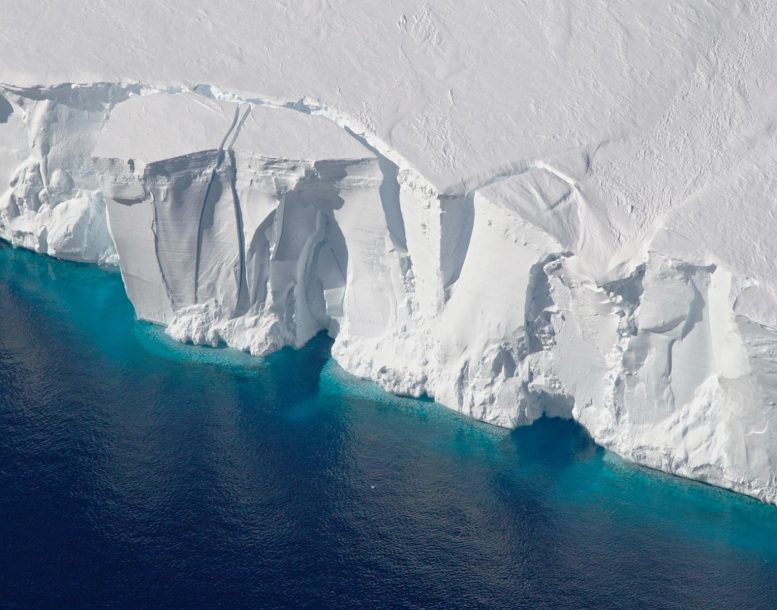
The Getz Ice Shelf in West Antarctica photographed from a NASA research airplane by Jeremy Harbeck, a sea ice scientist at NASA Goddard. The image shows ice in the process of calving from the front of the shelf, soon to become an iceberg. Credit: NASA/Jeremy Harbeck
Study finds even the tallest ice cliffs should support their own weight rather than collapsing catastrophically.
Antarctica’s ice sheet spans close to twice the area of the contiguous United States, and its land boundary is buttressed by massive, floating ice shelves extending hundreds of miles out over the frigid waters of the Southern Ocean. When these ice shelves collapse into the ocean, they expose towering cliffs of ice along Antarctica’s edge.
Scientists have assumed that ice cliffs taller than 90 meters (300 feet) (about the height of the Statue of Liberty) would rapidly collapse under their own weight, contributing to more than 6 feet (1.8 meters) of sea-level rise by the end of the century — enough to completely flood Boston and other coastal cities. But now MIT researchers have found that this particular prediction may be overestimated.
In a paper published today in Geophysical Research Letters, the team reports that in order for a 90-meter ice cliff to collapse entirely, the ice shelves supporting the cliff would have to break apart extremely quickly, within a matter of hours — a rate of ice loss that has not been observed in the modern record.
“Ice shelves are about a kilometer thick, and some are the size of Texas,” says MIT graduate student Fiona Clerc. “To get into catastrophic failures of really tall ice cliffs, you would have to remove these ice shelves within hours, which seems unlikely no matter what the climate-change scenario.”
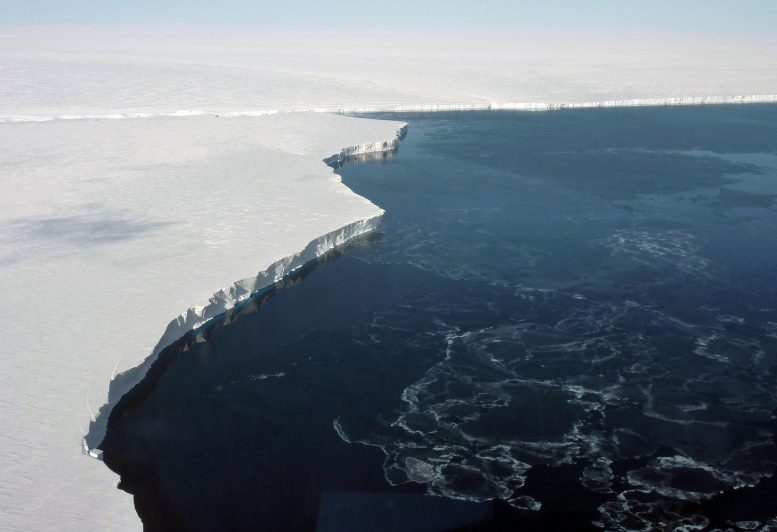
The Getz Ice Shelf extends several miles into the ocean from the Getz glacier as it empties into the ocean along the Antarctic coast. The vertical face of the ice shelf is almost 200 feet (60 meters) high and is estimated to extend another 1000 feet (300 meters) below the ocean surface. This photo was taken from NASA’s DC-8 flying science laboratory during an IceBridge mission flight. Credit: NASA/Dick Ewers
If a supporting ice shelf were to melt away over a longer period of days or weeks, rather than hours, the researchers found that the remaining ice cliff wouldn’t suddenly crack and collapse under its own weight, but instead would slowly flow out, like a mountain of cold honey that’s been released from a dam.
“The current worst-case scenario of sea-level rise from Antarctica is based on the idea that cliffs higher than 90 meters would fail catastrophically,” Brent Minchew, assistant professor in MIT’s Department of Earth, Atmospheric and Planetary Sciences. “We’re saying that scenario, based on cliff failure, is probably not going to play out. That’s something of a silver lining. That said, we have to be careful about breathing a sigh of relief. There are plenty of other ways to get a rapid sea-level rise.”
Clerc is the lead author of the new paper, along with Minchew, and Mark Behn of Boston College.
Silly putty-like behavior
In a warming climate, as Antarctica’s ice shelves collapse into the ocean, they expose towering cliffs of grounded ice, or ice over land. Without the buttressing support of ice shelves, scientists have assumed that the continent’s very tall ice cliffs would collapse, calving into the ocean, to expose even taller cliffs further inland, which would themselves fail and collapse, initiating a runaway ice-sheet retreat.
Today, there are no ice cliffs on Earth that are taller than 90 meters, and scientists assumed this is because cliffs any taller than that would be unable to support their own weight.
Clerc, Minchew, and Behn took on this assumption, wondering whether and under what conditions ice cliffs 90 meters and taller would physically collapse. To answer this, they developed a simple simulation of a rectangular block of ice to represent an idealized ice sheet (ice over land) supported initially by an equally tall ice shelf (ice over water). They ran the simulation forward by shrinking the ice shelf at different rates and seeing how the exposed ice cliff responds over time.
In their simulation, they set the mechanical properties, or behavior of ice, according to Maxwell’s model for viscoelasticity, which describes the way a material can transition from an elastic, rubbery response, to a viscous, honey-like behavior depending on whether it is quickly or slowly loaded. A classic example of viscoelasticity is silly putty: If you leave a ball of silly putty on a table, it slowly slumps into a puddle, like a viscous liquid; if you quickly pull it apart, it tears like an elastic solid.
As it turns out, ice is also a viscoelastic material, and the researchers incorporated Maxwell viscoelasticity into their simulation. They varied the rate at which the buttressing ice shelf was removed, and predicted whether the ice cliff would fracture and collapse like an elastic material or flow like a viscous liquid.
They model the effects of various starting heights, or thicknesses of ice, from 0 to 1,000 meters (3,300 feet), along with various timescales of ice shelf collapse. In the end, they found that when a 90-meter cliff is exposed, it will quickly collapse into brittle chunks only if the supporting ice shelf has been removed quickly, over a period of hours. In fact, they found that this behavior holds true for cliffs as tall as 500 meters (1,600 feet). If ice shelves are removed over longer periods of days or weeks, ice cliffs as tall as 500 meters will not collapse under their own weight, but instead will slowly slough away, like cold honey.
A realistic picture
The results suggest that the Earth’s tallest ice cliffs are unlikely to collapse catastrophically and trigger a runaway ice sheet retreat. That’s because the fastest rate at which ice shelves are disappearing, at least as documented in the modern record, is on the order of weeks, not hours, as scientists observed in 2002, when they captured satellite imagery of the collapse of the Larsen B ice shelf — a chunk of ice as large as Rhode Island that broke away from Antarctica, shattering into thousands of icebergs over the span of two weeks.
“When Larsen B collapsed, that was quite an extreme event that occurred over two weeks, and that is a tiny ice shelf compared to the ones that we would be particularly worried about,” Clerc says. “So our work shows that cliff failure is probably not the mechanism by which we would get a lot of sea level rise in the near future.”
This research is supported, in part, by the National Science Foundation.
Reference: “Marine Ice Cliff Instability Mitigated by Slow Removal of Ice Shelves” by Fiona Clerc, Brent M. Minchew and Mark D. Behn, 21 October 2019, Geophysical Research Letters.
DOI: 10.1029/2019GL084183


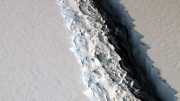

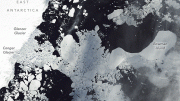
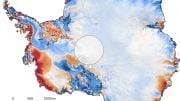


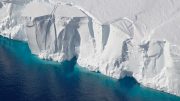
Those scientists are Trump supporters?
No, they are just refining the science, like climate scientists in general are doing. This doesn’t mean they don’t understand the extreme danger of AGW.
Just because of conclusions you don’t like, you assume that it is take? You are as bad as those Trump supporters you are referring to. Talk about pot calling kettle black!
Is this just a study? Has it been peer reviewed and accepted by the scientific community? I see no citations, so I must assume that it’s still just another theory.
@realHobbit
the sea level increase is for me math, for you just a pot. Those guys and gals from MIT just want to say that the world still has a looooooooot of time, kettle!
The downplay? Or better science?
GRL is a legitimate, peer reviewed scientific journal around since 1974, and was the 5th most cited publication in climate change in the past decade.
This doesn’t necessarily save us. If the ice sheet thins to 90 meters, in a lot of areas it will be floating instead of grounded, very vulnerable to melting and cracking.
In the brittle scenario, crumbled ice would retain the ice wall for a little while, but not for long. In the flow scenario, thin ice would retain the ice wall as long as it lasted – but would it be much more effective than packed icebergs?
This study, as described here, makes too many assumptions – we can’t apply its conclusions as broadly as the article is trying to sell.
this sucks poooooooooooooooooooooooooooooooooooooooooooooooooooooooooooooooooooooop
“… at least as documented in the modern record…”
Unfortunately, conditions are already out of whack with anything documented in the modern record, or for that matter, in the previous geologic history of our planet, that we’ve found so far.
@ Richard Mercer
You’re right, but the style how the article is written evoke something else.
The problematic is very complex. Simplified, the main problem is the reduction of ice surface and not the volume.
By reduction of ice surface less sunlight is reflected = more light / heat is absorbed which increases the water and consecutively the earth temperature speeding up cliff melting and so increasing the sea level.
It’s like an perpetum mobile…